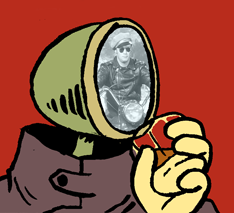Neutron stars are the most compact form of matter that we know about; they’re even denser than the nucleus of an atom.
Neutrons, protons and electrons are fermions, meaning they must obey the Pauli exclusion principle. No two neutrons (or protons or electrons) can be in the same quantum mechanical state. If you take ordinary star matter (plasma made of dissociated protons and electrons) and squeeze it, eventually the electrons will nearly overlap in their states. You’d have two electrons with nearly the same energy, spin and location. They cannot overlap though, so this creates a repulsive force that prevents the matter from further compression; this is called the electron degeneracy pressure.
If the compressive force overcomes this pressure, then the electrons can capture on the protons to form neutrons. Neutrons and protons also have degeneracy pressures, but they can be packed much more densely than electrons. This is because their wavelength is shorter. The wavelength of a massive particle is inversely proportional to its mass, and protons and electrons are about 2000 times the mass of electrons. So compressed ordinary matter will inevitably become pure neutrons, simply because this is the most compact form.
A pure electron or pure proton star wouldn’t be as compact because both are charged particles so there would be Coulomb repulsion (this isn’t an issue in ordinary matter since the number of electrons and protons is roughly equal). You’d also need to somehow separate the electrons from the protons, and this isn’t a process that would naturally occur in a collapsing star.
Because neutrons are what you get when an elecron and a proton love each other very very much…
So basically if you sqeeze anything (made of atoms) hard enough you get neutrons.
It’s not like it’s “impossible” to sqeeze a bunch of protons, but stuff is usually made of atoms, not of protons, hence you don’t get such a weird thing as a giant segregation of protons just lying there.
Because neutrons are what you get when an electron and a proton love each other very very much…
What occurs to me now that you put it that way, is from way back during the very early days of galactic formation, when so much hydrogen gas got blasted by radiation (was that caused by Population I stars?), stripping the electron away and leaving most of the hydrogen ionized - a fancy way of saying “lone protons floating in space”.
Now what would happen if some ionized hydrogen clouds happened to collapse into massive stars during this window of time, before the universe became re-ionized? Massive stars with mostly protons and very few electrons?
Is this a valid hypothetical object? Then if it collapses under it’s own proton weight, where are you going to get the electrons to merge with the protons to transform into neutrons?
Probably the simplest answer is protons and electrons repel themselves with a force far stronger than gravity. Neutrons don’t repel themselves in that way.
deleted by creator
I’m starting here: https://physics.stackexchange.com/questions/116921/can-there-be-electron-and-or-proton-stars
I don’t have the physics chops to understand most of what is being said, but if I can bang rocks together for a moment it sounds like it would fly apart, or, if you forced it all together somehow they would literally become neutrons.


